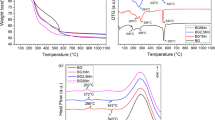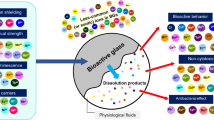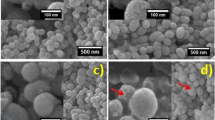Abstract
Bioactive glasses (BGs) are widely used for bone regeneration, and allow the incorporation of different ions with therapeutic properties into the glass network. Amongst the different ions with therapeutic benefits, manganese (Mn) has been shown to influence bone metabolism and activate human osteoblasts integrins, improving cell adhesion, proliferation and spreading. Mn has also been incorporated into bioceramics as a therapeutic ion for improved osteogenesis. Here, up to 4.4 mol% MnO was substituted for CaO in the 58S composition (60 mol% SiO2, 36 mol% CaO, 4 mol% P2O5) and its effects on the glass properties and capability to influence the osteogenic differentiation were evaluated. Mn-containing BGs with amorphous structure, high specific surface area and nanoporosity were obtained. The presence of Mn2+ species was confirmed by X-ray photoelectron spectroscopy (XPS). Mn-containing BGs presented no cytotoxic effect on human mesenchymal stem cells (hMSCs) and enabled sustained ion release in culture medium. hMSCs osteogenic differentiation stimulation and influence on the mineralisation process was also confirmed through the alkaline phosphatase (ALP) activity, and expression of osteogenic differentiation markers, such as collagen type I, osteopontin and osteocalcin, which presented higher expression in the presence of Mn-containing samples compared to control. Results show that the release of manganese ions from bioactive glass provoked human mesenchymal stem cell (hMSC) differentiation down a bone pathway, whereas hMSCs exposed to the Mn-free glass did not differentiate. Mn incorporation offers great promise for obtaining glasses with superior properties for bone tissue regeneration.












Similar content being viewed by others
References
Hench LL, Splinter RJ, Allen WC, Greenlee TK. Bonding mechanisms at the interface of ceramic prosthetic materials. J Biomed Mater Res. 1971;5:117–41. https://doi.org/10.1002/jbm.820050611.
Baino F. Bioactive glasses—when glass science and technology meet regenerative medicine. Ceram Int. 2018;44:14953–66. https://doi.org/10.1016/j.ceramint.2018.05.180.
Jones JR, Brauer DS, Hupa L, Greenspan DC. Bioglass and bioactive glasses and their impact on healthcare. Int J Appl Glas Sci. 2016;7:423–34. https://doi.org/10.1111/ijag.12252.
Xynos ID, Edgar AJ, Buttery LDK, Hench LL, Polak JM. Gene-expression profiling of human osteoblasts following treatment with the ionic products of Bioglass 45S5 dissolution. J Biomed Mater Res. 2001;55:151–7. https://doi.org/10.1002/1097-4636(200105)55:2<151::AID-JBM1001>3.0.CO;2-D.
Bosetti M, Cannas M. The effect of bioactive glasses on bone marrow stromal cells differentiation. Biomaterials. 2005;26:3873–9. https://doi.org/10.1016/j.biomaterials.2004.09.059.
Reilly GC, Radin S, Chen AT, Ducheyne P. Differential alkaline phosphatase responses of rat and human bone marrow derived mesenchymal stem cells to 45S5 bioactive glass. Biomaterials. 2007;28:4091–7. https://doi.org/10.1016/j.biomaterials.2007.05.038.
Bielby RC, Phil D, Pryce RS, Phys M, Ph D, Hench LL et al. Enhanced derivation of osteogenic cells from murine embryonic stem cells after treatment with ionic dissolution products of 58S bioactive sol–gel glass. Tissue Eng. 2005;11:479–88.
Houreh AB, Labbaf S, Ting H-K, Ejeian F, Jones JR, Esfahani M-HN. Influence of calcium and phosphorus release from bioactive glasses on viability and differentiation of dental pulp stem cells. J. Mater. Sci. 2017. https://doi.org/10.1007/s10853-017-0946-4.
Jones JR. Review of bioactive glass: from Hench to hybrids. Acta Biomater. 2013;9:4457–86. https://doi.org/10.1016/j.actbio.2012.08.023.
Baino F, Fiume E, Miola M, Verné E. Bioactive sol–gel glasses: rocessing, properties, and applications. Int J Appl Ceram Technol. 2018;15:841–60. https://doi.org/10.1111/ijac.12873.
Naruphontjirakul P, Greasley SL, Chen S, Porter AE, Jones JR. Monodispersed strontium containing bioactive glass nanoparticles and MC3T3-E1 cellular response. Biomed Glas. 2016;2:72–81. https://doi.org/10.1515/bglass-2016-0009.
Naruphontjirakul P, Porter AE, Jones JR. In vitro osteogenesis by intracellular uptake of strontium containing bioactive glass nanoparticles. Acta Biomater. 2018;66:67–80. https://doi.org/10.1016/j.actbio.2017.11.008.
Gentleman E, Fredholm YC, Jell G, Lotfibakhshaiesh N, O’Donnell MD, Hill RG et al. The effects of strontium-substituted bioactive glasses on osteoblasts and osteoclasts in vitro. Biomaterials. 2010;31:3949–56. https://doi.org/10.1016/j.biomaterials.2010.01.121.
Santocildes-romero ME, Crawford A, Hatton PV, Goodchild RL, Reaney IM, Miller CA. The osteogenic response of mesenchymal stromal cells to strontium-substituted bioactive glasses. J Tissue Eng Regen Med. 2015;9:619–31. https://doi.org/10.1002/term.2003.
Yang F, Yang D, Tu J, Zheng Q, Cai L, Wang L. Strontium enhances osteogenic differentiation of mesenchymal stem cells and in vivo bone formation by activating Wnt/catenin. Stem Cells. 2011;29:981–91. https://doi.org/10.1002/stem.646.
Cabrini L, Lo MP, Gorustovich AA, Steimetz T, Bfdq MP. Osteoconductivity of strontium-doped bioactive glass particles: a histomorphometric study in rats. J Biomed Mater Res Part A. 2009;92A:232–7. https://doi.org/10.1002/jbm.a.32355.
Autefage H, Gentleman E, Littmann E, Hedegaard MAB, Von Erlach T, O’Donnell M et al. Sparse feature selection methods identify unexpected global cellular response to strontium-containing materials. PNAS. 2015;112:4280–5. https://doi.org/10.1073/pnas.1419799112.
Naruphontjirakul P, Tsigkou O, Li S, Porter AE, Jones JR Human mesenchymal stem cells differentiate into an osteogenic lineage in presence of strontium containing bioactive glass nanoparticles, Acta Biomater. 2019. https://doi.org/10.1016/j.actbio.2019.03.038.
Pires EG, Bonan RF, Rocha ÍM, Gonçalves IMF, de Souza JR, Gonzales LHV et al. Silver-doped 58S bioactive glass as an anti-Leishmania agent. Int J Appl Glas Sci. 2017;1:52–61. https://doi.org/10.1111/ijag.12285.
Rahimnejad Yazdi A, Torkan L, Stone W, Towler MR. The impact of gallium content on degradation, bioactivity, and antibacterial potency of zinc borate bioactive glass. J. Biomed. Mater. Res. Part B Appl. Biomater. 2017: 1–10. https://doi.org/10.1002/jbm.b.33856.
Barrioni BR, de Laia AGS, Valverde TM, da TM, Martins M, Caliari MV et al. Evaluation of in vitro and in vivo biocompatibility and structure of cobalt-releasing sol–gel bioactive glass. Ceram Int. 2018;44:20337–47. https://doi.org/10.1016/j.ceramint.2018.08.022.
Azevedo M, Jell G, O’Donnell M, Law R, Hill R, Stevens M. Synthesis and characterization of hypoxia-mimicking bioactive glasses for skeletal regeneration. J Mater Chem. 2010;20:8854–64. https://doi.org/10.1039/c0jm01111h.
Romero-Sánchez LB, Marí-Beffa M, Carrillo P, Medina MÁ, Díaz-Cuenca A, Copper-containing mesoporous bioactive glass promotes angiogenesis in an in vivo zebrafish model, Acta Biomater. 2018. https://doi.org/10.1016/j.actbio.2017.12.032.
Kargozar S, Lotfibakhshaiesh N, Ai J, Mozafari M, Brouki Milan P, Hamzehlou S et al. Strontium- and cobalt-substituted bioactive glasses seeded with human umbilical cord perivascular cells to promote bone regeneration via enhanced osteogenic and angiogenic activities. Acta Biomater. 2017;58:502–14. https://doi.org/10.1016/j.actbio.2017.06.021.
Lüthen F, Bulnheim U, Müller PD, Rychly J, Jesswein H, Nebe JGB. Influence of manganese ions on cellular behavior of human osteoblasts in vitro. Biomol Eng. 2007;24:531–6. https://doi.org/10.1016/j.bioeng.2007.08.003.
Miola M, Brovarone CV, Maina G, Rossi F, Bergandi L, Ghigo D et al. In vitro study of manganese-doped bioactive glasses for bone regeneration. Mater Sci Eng C. 2014;38:107–18. https://doi.org/10.1016/j.msec.2014.01.045.
Bae YJ, Kim MH. Manganese supplementation improves mineral density of the spine and femur and serum osteocalcin in rats. Biol Trace Elem Res. 2008;124:28–34. https://doi.org/10.1007/s12011-008-8119-6.
Fujitani W, Hamada Y, Kawaguchi N, Mori S, Daito K, Uchinaka A et al. Synthesis of hydroxyapatite containing manganese and its evaluation of biocompatibility. Nano Biomed 2010;2:37–46. https://doi.org/10.11344/nano.2.37.
Torres PMC, Vieira SI, Cerqueira aR, Pina S, Da Cruz Silva OaB, Abrantes JCC et al. Effects of Mn-doping on the structure and biological properties of β-tricalcium phosphate. J Inorg Biochem 2014;136:57–66. https://doi.org/10.1016/j.jinorgbio.2014.03.013.
Yu L, Tian Y, Qiao Y, Liu X. Mn-containing titanium surface with favorable osteogenic and antimicrobial functions synthesized by PIII&D. Colloids Surf B Biointerfaces. 2017;152:376–84. https://doi.org/10.1016/j.colsurfb.2017.01.047.
Sharma N, Jandaik S, Kumar S, Chitkara M, Sandhu IS. Synthesis, characterisation and antimicrobial activity of manganese- and iron-doped zinc oxide nanoparticles. J Exp Nanosci. 2016;11:54–71. https://doi.org/10.1080/17458080.2015.1025302.
Nawaz Q, Atiq M, Rehman U, Burkovski A, Schmidt J, Beltrán AM. et al., Synthesis and characterization of manganese containing mesoporous bioactive glass nanoparticles for biomedical applications. J. Mater. Sci. Mater. Med. 2018;5: https://doi.org/10.1007/s10856-018-6070-4.
Barrioni BR, Oliveira AC, de Fátima Leite M, de Magalhães Pereira M. Sol–gel-derived manganese-releasing bioactive glass as a therapeutic approach for bone tissue engineering. J Mater Sci. 2017;52:8904–27. https://doi.org/10.1007/s10853-017-0944-6.
Li R, Clark AE, Hench LL. An investigation of bioactive glass powders by sol–gel processing. J Appl Biomater. 1991;2:231–9. https://doi.org/10.1002/jab.770020403.
Brunauer S, Emmett PH, Teller E. Gases in multimolecular layers. J Am Chem Soc. 1938;60:309–19. https://doi.org/10.1021/ja01269a023.
Barrett EP, Joyner LG, Halenda PP. The determination of pore volume and area distributions in porous substances. I. Computations from nitrogen isotherms. J Am Chem Soc. 1951;73:373–80. https://doi.org/10.1021/ja01145a126.
Maçon ALB, Kim TB, Valliant EM, Goetschius K, Brow RK, Day DE et al. A unified in vitro evaluation for apatite-forming ability of bioactive glasses and their variants. J Mater Sci Mater Med. 2015;26:115 https://doi.org/10.1007/s10856-015-5403-9.
de Oliveira AAR, de Souza DA, Dias LLS, de Carvalho SM, Mansur HS, de Magalhães M. Pereira, Synthesis, characterization and cytocompatibility of spherical bioactive glass nanoparticles for potential hard tissue engineering applications. Biomed Mater. 2013;8:025011 https://doi.org/10.1088/1748-6041/8/2/025011.
Perez-Pariente J, Balas F, Vallet-Regi M. Surface and chemical study of SiO2·P2O5·CaO·(MgO) bioactive glasses. Chem Mater. 2000;12:750–5. https://doi.org/10.1021/cm9911114.
Lin S, Ionescu C, Pike KJ, Smith ME, Jones JR. Nanostructure evolution and calcium distribution in sol–gel derived bioactive glass. J Mater Chem. 2009;19:1276–82. https://doi.org/10.1039/b814292k.
Atkinson I, Anghel EM, Predoana L, Mocioiu OC, Jecu L, Raut I et al. Influence of ZnO addition on the structural, in vitro behavior and antimicrobial activity of sol–gel derived CaO–P2O5–SiO2 bioactive glasses. Ceram Int. 2016;42:3033–45. https://doi.org/10.1016/j.ceramint.2015.10.090.
Gunawidjaja PN, Mathew R, Lo aYH, Izquierdo-Barba I, Garcia a, Arcos D et al. Local structures of mesoporous bioactive glasses and their surface alterations in vitro: inferences from solid-state nuclear magnetic resonance. Philos Trans R Soc A Math Phys Eng Sci. 2012;370:1376–99. https://doi.org/10.1098/rsta.2011.0257.
El-Kady AM, Ali AF. Fabrication and characterization of ZnO modified bioactive glass nanoparticles. Ceram Int. 2012;38:1195–204. https://doi.org/10.1016/j.ceramint.2011.07.069.
Moreira CDF, Carvalho SM, Mansur HS, Pereira MM. Thermogelling chitosan–collagen–bioactive glass nanoparticle hybrids as potential injectable systems for tissue engineering. Mater Sci Eng C. 2016;58:1207–16. https://doi.org/10.1016/j.msec.2015.09.075.
Lusvardi G, Malavasi G, Menabue L, Shruti S. Gallium-containing phosphosilicate glasses: functionalization and in-vitro bioactivity. Mater Sci Eng C. 2013;33:3190–6. https://doi.org/10.1016/j.msec.2013.03.046.
Paluszkiewicz C, Ślósarczyk A, Pijocha D, Sitarz M, Bućko M, Zima A et al. Synthesis, structural properties and thermal stability of Mn-doped hydroxyapatite. J Mol Struct. 2010;976:301–9. https://doi.org/10.1016/j.molstruc.2010.04.001.
Ting H-K, Page S, Poologasundarampillai G, Chen S, Hanna JV, Jones JR. Phosphate content affects structure and bioactivity of sol–gel silicate bioactive glasses. Int. J. Appl. Glas. Sci. 2017. https://doi.org/10.1111/ijag.12322.
Saboori A, Rabiee M, Moztarzadeh F, Sheikhi M, Tahriri M, Karimi M. Synthesis, characterization and in vitro bioactivity of sol–gel-derived SiO2-CaO-P2O5-MgO bioglass. Mater Sci Eng C. 2009;29:335–40. https://doi.org/10.1016/j.msec.2008.07.004.
Toufiq AM, Wang F, Javed Q, Li Y. Influence of SiO2 on the structure-controlled synthesis and magnetic properties of prismatic MnO2 nanorods. Nanotechnology. 2013;24:415703 https://doi.org/10.1088/0957-4484/24/41/415703.
Fayon F, Duée C, Poumeyrol T, Allix M, Massiot D. Evidence of nanometric-sized phosphate clusters in bioactive glasses as revealed by solid-state 31P NMR. J Phys Chem C. 2013;117:2283–8. https://doi.org/10.1021/jp312263j.
Gostynski R, Conradie J, Erasmus E. Significance of the electron-density of molecular fragments on the properties of manganese(iii) β-diketonato complexes: an XPS and DFT study. RSC Adv. 2017;7:27718–28. https://doi.org/10.1039/C7RA04921H.
Biesinger MC, Payne BP, Grosvenor AP, Lau LWM, Gerson AR, Smart RSC. Resolving surface chemical states in XPS analysis of first row transition metals, oxides and hydroxides: Cr, Mn, Fe, Co and Ni. Appl Surf Sci. 2011;257:2717–30. https://doi.org/10.1016/j.apsusc.2010.10.051.
Cerrato JM, Hochella MF, Knocke WR, Dietrich AM, Cromer TF. Use of XPS to identify the oxidation state of Mn in solid surfaces of filtration media oxide samples from drinking water treatment plants. Environ Sci Technol. 2010;44:5881–6. https://doi.org/10.1021/es100547q.
Nesbitt HW, Banerjee D. Interpretation of XPS Mn(2p) spectra of Mn oxyhydroxides and constraints on the mechanism of MnO2 precipitation. Am Miner. 1998;83:305–15. https://doi.org/10.2138/am-1998-3-414.
Poinsignon C, Berthome G, Prélot B, Thomas F, Villiéras F. Manganese dioxides surface properties studied by XPS and gas adsorption. J Electrochem Soc. 2004;151:A1611–6. https://doi.org/10.1149/1.1789411.
Bulavchenko OA, Vinokurov ZS, Afonasenko TN, Tsyrul’nikov PG, Tsybulya SV, Saraev AA et al. Reduction of mixed Mn–Zr oxides: in situ XPS and XRD. Stud, Dalt Trans. 2015;44:15499–507. https://doi.org/10.1039/C5DT01440A.
Pascuta P, Borodi G, Jumate N, Vida-Simiti I, Viorel D, Culea E. The structural role of manganese ions in some zinc phosphate glasses and glass ceramics. J Alloy Compd. 2010;504:479–83. https://doi.org/10.1016/j.jallcom.2010.05.147.
Gaddam A, Fernandes HR, Tulyaganov DU, Pascual MJ, Ferreira JMF. Role of manganese on the structure, crystallization and sintering of non-stoichiometric lithium disilicate glasses. RSC Adv. 2014;4:13581 https://doi.org/10.1039/c3ra46393a.
Regan E, Groutso T, Metson JB, Steiner R, Ammundsen B, Hassell D et al. Surface and bulk composition of lithium manganese oxides. Surf Interface Anal. 1999;27:1064–8. https://doi.org/10.1002/(SICI)1096-9918(199912)27:12<1064::AID-SIA676>3.0.CO;2-S.
Goel A, Rajagopal RR, Ferreira JMF. Influence of strontium on structure, sintering and biodegradation behaviour of CaO–MgO–SrO–SiO2–P2O5–CaF2 glasses. Acta Biomater. 2011;7:4071–80. https://doi.org/10.1016/j.actbio.2011.06.047.
Azevedo MM, Tsigkou O, Nair R, Jones JR, Jell G, Stevens MM. Hypoxia inducible factor-stabilizing bioactive glasses for directing mesenchymal stem cell behavior. Tissue Eng Part A 2014;00:1–8. https://doi.org/10.1089/ten.TEA.2014.0083.
Caplan AI. Adult mesenchymal stem cells for tissue engineering versus regenerative medicine. J Cell Physiol 2007;213:341–7. https://doi.org/10.1002/jcp.21200.
Safadi FF, Barbe MF, Abdelmagid SM, Rico MC, Aswad RA Bone structure, development and bone biology: bone pathology. In: Bone Pathology; 2009. https://doi.org/10.1007/978-1-59745-347-9_1.
Khorami M, Hesaraki S, Behnamghader A, Nazarian H, Shahrabi S. In vitro bioactivity and biocompatibility of lithium substituted 45S5 bioglass. Mater Sci Eng C. 2011;31:1584–92. https://doi.org/10.1016/j.msec.2011.07.011.
Wu C, Xia L, Han P, Mao L, Wang J, Zhai D et al. Europium-containing mesoporous bioactive glass scaffolds for stimulating in vitro and in vivo osteogenesis. ACS Appl Mater Interfaces. 2016;8:11342–54. https://doi.org/10.1021/acsami.6b03100.
Effah Kaufmann EA, Ducheyne P, Shapiro IM. Evaluation of osteoblast response to porous bioactive glass (45S5) substrates by RT-PCR analysis. Tissue Eng. 2000;6:19–28. https://doi.org/10.1089/107632700320856.
Thurner PJ, Chen CG, Ionova-martin S, Sun L, Harman A, Porter A et al. Osteopontin deficiency increases bone fragility but preserves bone mass. Bone. 2010;46:1564–73. https://doi.org/10.1016/j.bone.2010.02.014.
Isaac J, Nohra J, Lao J, Jallot E, Nedelec JM, Berdal A et al. Effects of strontium-doped bioactive glass on the differentiation of cultured osteogenic cells. Eur Cells Mater. 2011;21:130–43.
LA Strobel, N Hild, D Mohn, WJ Stark, A Hoppe, U Gbureck, RE Horch, U Kneser, AR Boccaccini, Novel strontium-doped bioactive glass nanoparticles enhance proliferation and osteogenic differentiation of human bone marrow stromal cells. J Nanopart Res. 2013;15. https://doi.org/10.1007/s11051-013-1780-5.
Acknowledgements
The authors acknowledge financial support from CNPq, CAPES and FAPEMIG/Brazil and to the Advanced Photoelectron Spectroscopy Laboratory (APSL—Department of Materials—Imperial College London) for XPS analysis.
Author information
Authors and Affiliations
Corresponding author
Ethics declarations
Conflict of interest
The authors declare that they have no conflict of interest.
Additional information
Publisher’s note: Springer Nature remains neutral with regard to jurisdictional claims in published maps and institutional affiliations.
Rights and permissions
About this article
Cite this article
Barrioni, B.R., Norris, E., Li, S. et al. Osteogenic potential of sol–gel bioactive glasses containing manganese. J Mater Sci: Mater Med 30, 86 (2019). https://doi.org/10.1007/s10856-019-6288-9
Received:
Accepted:
Published:
DOI: https://doi.org/10.1007/s10856-019-6288-9




